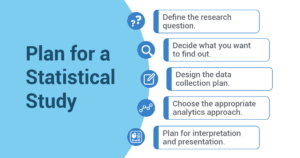Picture this: It’s a Saturday morning, and you wake up with an undeniable craving for a mouthwatering slice of pizza 🍕. Your taste buds are tingling, and your stomach is growling in anticipation. But wait! You realize you’ve never been to this particular pizza place before. How do you decide if it’s worth your time and money? You might be surprised to know that at that moment, you are instinctively engaging in a process similar to planning a statistical investigation🕵️♂️.
You see, statistical investigations are not just reserved for scientists in lab coats or mathematicians in ivory towers. No, they are woven into the fabric of our everyday lives. We are constantly faced with questions ❓and uncertainties, big and small, and we seek answers to make informed decisions. Just like that slice of pizza, we crave knowledge that guides us toward the best possible outcome.
But how do we ensure that our pursuit of answers is accurate, reliable, and meaningful? That’s where planning a statistical investigation comes into play. By taking a moment to step back, contemplate our goals, and map out our path, we can unlock a world of clarity and insight.
Think about it: Have you ever wondered which study method is most effective? Or which smartphone model 📱 has the best battery life? Perhaps you’ve pondered whether certain foods make you feel energized or sluggish 😴. In these moments, you are essentially creating your own mini-statistical investigations. You devise a plan, gather data by observing, asking questions, or conducting experiments, and analyze the information to draw conclusions.
Statistical investigations are not just reserved for academics or researchers. They are part of our natural curiosity and quest for knowledge. Every day, albeit informally, we engage in the art of planning to find the answers we seek and make better choices. Let’s explore the power of planning a statistical investigation and how it can unlock a world of understanding in our everyday lives.
Benefits of Planning a Statistical Investigation
- Having a plan is like having a roadmap. It guides us in the right direction, helps us gather the right data, and ensures we’re asking the right questions. Without a plan, we might end up lost and confused, not knowing if our results are accurate or if we missed something important.
- Having a good plan leads to better results. When we take the time to carefully design our study, figure out how to collect data, and choose the right methods to analyze it, we can avoid mistakes and biases that might make our conclusions wrong. A well-thought-out plan helps us think about possible errors, control the things we’re measuring, and use reliable methods, so our results are more accurate and make more sense.
- Plans also help us be prepared for problems that might come up. Even in statistical investigations, there can be challenges. But if we have a good plan, we can think ahead and come up with solutions before the problems happen. This way, we save time and energy, and our study stays trustworthy and reliable. So, having a plan is like having a superpower that helps us do a better job!
By creating a plan, we can make our statistical investigation more reliable, get better results, and have a clearer understanding of the world around us.
Creating a Plan for a Statistical Study
- Define the research question: The first step in planning a statistical investigation is to clearly define the question or problem you want to study. This helps you know what you’re trying to find out and gives your study a solid starting point.
- Decide what you want to find out: Once you have your research question, it’s important to think about what specific information or insights you want to uncover. This helps you focus on the most important things to learn and guides your planning process.
- Plan for collecting data: After you know what you want to find out, it’s time to create a plan for collecting the data you need. This means choosing the best ways to gather information, like surveys or experiments, and deciding how many samples or measurements to collect. A good data collection plan makes sure you get accurate and reliable information.
- Choose the right way to analyze the data: Once you have all the data, it’s time to analyze it to make sense of what you found. This step involves deciding which statistical methods and techniques to use based on your research question and the type of data you have. Picking the right analysis approach helps you draw meaningful conclusions from the data.
- Plan how to explain and show your results: The final step in planning is to think about how you will interpret and present your findings. This can involve using graphs, charts, written reports, or presentations to share your results with others. Planning helps you present your findings clearly and effectively so others can understand what you discovered.
Learn how Chris Used Planning to Ensure a Successful Investigation:

First, Chris needed to define a clear research question that would guide his investigation. After careful consideration, he settled on the query: “Does adopting effective study habits have a positive impact on students’ academic performance?” This question captured the essence of his curiosity, directing his efforts toward understanding the potential correlation between study habits and improved grades among his classmates.
With the research question in mind, Chris now had to outline his plan for data collection. He decided to employ a survey-based approach, using a questionnaire to gather the necessary information. The survey would delve into various aspects of study habits, including time management, note-taking techniques, utilization of study aids, and the importance of studying in a distraction-free environment. To ensure the findings were representative, Chris aimed to administer the survey to a diverse sample of 10th-grade students from different schools.
To guarantee the sample accurately reflected the entire population of 10th-grade students, Chris carefully selected his participants using sampling methods. He understood the importance of a sufficiently large sample size for statistical power calculations to ensure the reliability of his study’s results.
Once the data collection was complete, Chris turned his attention to the best way to analyze the gathered information. He planned to utilize special techniques tailored to his research objective. Descriptive statistics would summarize the study habits reported by the participants, providing insights into their study habits, such as the amount of time they spent studying. Moreover, correlation analysis would help identify any links between study habits and academic performance, illuminating whether certain habits were associated with better grades. If necessary, Chris was prepared to employ regression analysis to determine which study habits had the most significant impact on academic performance.
Looking ahead to the interpretation and presentation of his findings, Chris recognized the importance of clarity and conciseness. He aimed to create visual representations, such as charts and graphs, to clearly illustrate the relationship between study habits and academic performance. Additionally, he planned to prepare a written report that would summarize the research question, methodology, findings, and conclusions. To share his results effectively, Chris considered giving a presentation to his 10th-grade peers, teachers, and school administrators, ensuring that the valuable insights gained from his study reached a broader audience.
